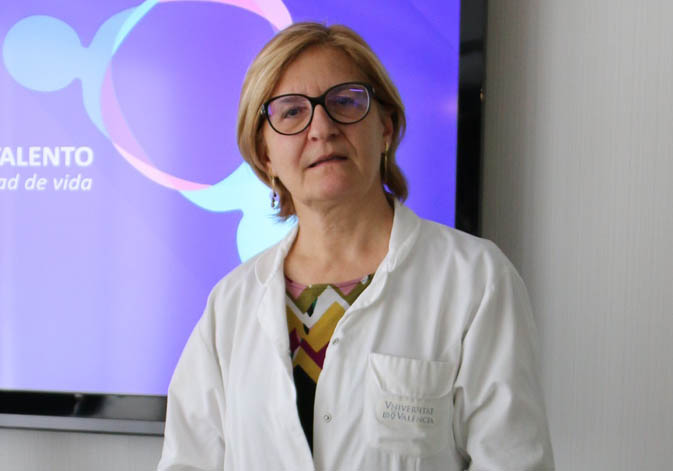A study led by Rosa Noguera opens the way to new personalised treatments of the neuroblastoma, the childhood cancer most common
- Scientific Culture and Innovation Unit
- May 14th, 2018

Rosa Noguera, full university professor of the Department of Pathology of the Universitat de València and member of the Research Translational Group of Solid Paediatric Tumours of INCLIVA. She is also the principal author of the published study in the journal 'Histology and Histopathology’. It could open way to new personalised treatments for the neuroblastoma, kind of childhood cancer most common. The results are focused on the glycosaminoglycan, a type of sugar that are in the extracellular matrix and whose presence are less than the tumours with worse prognosis.
Data obtained by Rosa Noguera allow to contemplate new treatments for some aggressive neuroblastomas involving in balancing the presence of this component through the induction of its synthesis by nanotechnology or restoring the gene B3GALT6, linked to production.
The study of the glycosaminoglycan has been realised in other tumours, such as melanoma. It is the first time that is used in the neuroblastoma. “In this research we have defined the pattern or quantity of this sugar in neuroblastic tumours, aggressive and non-aggressive. We have also seen that in the seconds are an increase of this substance”, pointed the researcher of INCLIVA and of the Universitat de València.
The analyse of digital microscopic image and elements of the extracellular matrix has been used to realised the pattern. “Thanks to this patterns, it is possible to reproduce the less aggressive pattern in tumours with more aggressiveness. If we can not totally remove the cancer, we can turn it in a chronic disease trying to resemble cell tissue of the more serious tumours to the less aggressive tumours. So that the patient responds in a positive manner to the therapy”, concludes the doctor.
As is the case of the majority of paediatric tumours, the neuroblastomas are considered childhood tumours. They only appear in childhood, being the most frequent solid tumours in the first year of life and the third more common in the childhood. In the case of adults, they are practically non-existent. They are a type of tumour that is not preventable. Because of that, the research seek to improve treatments and therapies. The personalisation is the key due to their extension, especially in the most aggressive cases.
“In patients with low risk, the current therapies work well and we are having good results, with high survival rates. Advances as those of the study are oriented to the high risk cases, with tumours of extreme aggressiveness or metastasis. In this concrete case, we have detected that in the most aggressive neuroblastomas, the glycosaminoglycan are scarce and that opens the door to find therapies based on their increase”, claimed Rosa Noguera.
Until now, space and components in cells were not so important. However, there are proof that in this context, it is closely connected with its nuclear and cytoplasmic matrix. In the extracellular matrix, there are multiple elements and among them, glycosaminoglycan. That is the type of sugar analysed by Rosa Noguera. “We see that when these sugar decreases, there is a higher aggressiveness in the tumour. Furthermore, the lack of glycosaminoglycan is associated to a genetic defect. Concretely, with a chromosome 1 deletion, where is the gene that encodes for an enzyme involved in the synthesis of this substance.
Project
The study of Rosa Noguera is part of a larger project and includes others aimed to know the different elements that take part of the extracellular matrix; “These substances would be reticulin fibres, collagen fibres, blood vessels and lymph vessels”, claims. According to research, there is increasing evidence that the rigidity of the extracellular matrix is related the aggressiveness of the cell. If tumour cell is softer and its outer is harder, metastasis is more likely and there are more possibilities that the disease advances.
Article:
Tadeo Cervera, Irene; Gamero Sandemetrio, Esther; Berbegall Beltrán, Ana Pilar Pilar; Navarro Fos, Samuel; Cañete Nieto, Adela; Noguera Salvá, Rosa: «1p36 deletion results in a decrease in glycosaminoglycans which is associated with aggressiveness in neuroblastic tumors». Histol Histopathol (2018) 33: 487-495. doi: https://doi.org/10.14670/HH-11-947
Link: http://ir.uv.es/DLhs3gG
File in: Investigació a la UV , Cultura Científica , Difusió i comunicació científica , Grups de recerca , Internacionalització recerca , Recerca, innovació i transferència
















